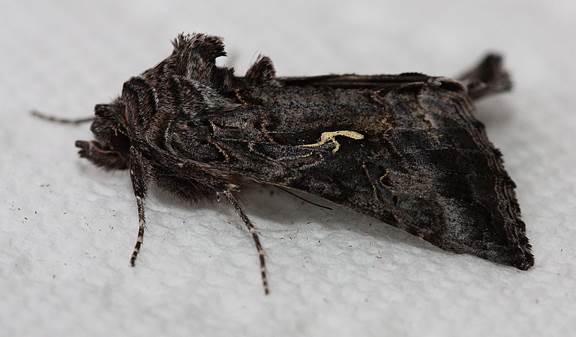January 5, 2014
Jeremy Tatum writes: I got a splendid present for Christmas – Mike Yip and James Miskelly’s brand new book Vancouver Island Butterflies. I don’t know how many are left in the bookstores, but if you haven’t got yours yet, I should go and get one quick, while they are still available. A must-have!
Jeremy Tatum writes: We were delighted to hear from the celebrated author and Booker Prize nominee Indra Sinha, from Sussex, England, who suggests that Guy Monty’s Catocala shown on the September 18 posting on this site may be Catocala briseis. Some of these Cats can be quite difficult, but I agree that briseis certainly seems to be a good fit to Monty’s photos.
Jeremy Tatum writes: I didn’t expect to see Autographa californica at this time of year, but one turned up at my Saanich apartment on December 13,

Autographa californica (Lep.: Noctuidae) Jeremy Tatum
Two comments so far on the proposal (in BC Nature mentioned in our December 12 posting) to introduce European butterflies to Salt Spring Island.
Mike Yip writes:
I certainly hope the plan to introduce alien butterflies is defeated. The proponents of the idea must be related to the people who thought introducing Starlings and House Sparrows was a good idea. If these people have time and money to waste they should be working on protecting natural habitats and saving our native species.
Aziza Cooper writes:
Is this person planning to release the introduced butterflies? Or will they be on display in an enclosed butterfly garden? If he is planning to release them, it’s difficult to forecast the effects of introductions, but so many plant and animal introductions have been so negative. House Sparrows, Starlings, Scotch Broom and Cane Toads are all disastrous lessons for us. Wouldn’t it be a better idea for him to work on enhancing and promoting native butterflies, instead of bringing in non-natives?
Jeremy Tatum responds: I read the article a few times, and I have to say that it is not clear as to whether he is planning to display the butterflies in an enclosure, or whether he is planning to release them into the wild. In either case it strikes me as an extraordinarily bad and irresponsible idea, and probably illegal. I cannot imagine for a moment any arm of government issuing a permit for this. As all naturalists know, we have an enormous number of introduced organisms of all kinds here. One could easily add to Mike’s and Aziza’s examples – Ivy, Spurge Laurel, Brown Rat and so on. The only European butterfly that has taken hold here is the Cabbage White – hardly a welcome addition to our fauna.
One might ask what are likely to be the adverse effects from introducing a few butterflies, most of which are nettle-feeders in the larval stage? A brief answer is that I do not know – which is one of the strongest arguments for not introducing them. One can rarely predict the effects of foreign introductions. One thing that could be predicted – the Small Tortoiseshell would inevitably interbreed with our Milbert’s Tortoiseshell. Or again in nature, the numbers of many of these butterflies are controlled by species-specific parasitoids, and, if these are absent on Salt Spring Island, the numbers of the introduced butterflies could multiply beyond control, to the detriment of our native species. Mike and Aziza are quite right – we should all be encouraged to work on enhancing and promoting native butterflies, instead of bringing in non-natives.
